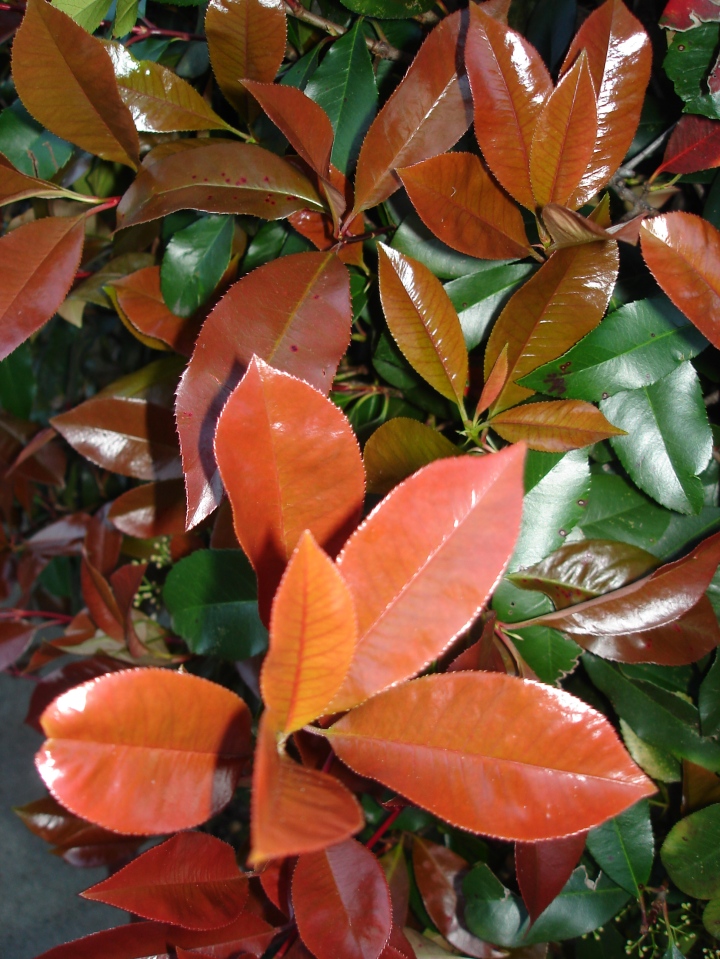 As a shorn evergreen hedge or simple shorn shrubbery, photinia, Photinia X fraseri, produces handsomely glossy bronzy red foliage without bloom. It is best if shorn as weather warms at the end of winter, and then allowed to grow out for a while. It can be shorn again through summer as bronzy foliage fades to green, but should not be shorn so often that it is always deprived of red foliage.
As a shorn evergreen hedge or simple shorn shrubbery, photinia, Photinia X fraseri, produces handsomely glossy bronzy red foliage without bloom. It is best if shorn as weather warms at the end of winter, and then allowed to grow out for a while. It can be shorn again through summer as bronzy foliage fades to green, but should not be shorn so often that it is always deprived of red foliage.
Without regular shearing, photinia becomes a small tree or large shrub. Trees can either be staked on single trunks, or allowed to develop multiple trunks. New growth in spring is not as vigorous as it would be in response to shearing, so is not as colorful. Domed trusses of tiny white flowers bloom about as soon as new foliage appears. The floral fragrance can be objectionable to some.
Only the biggest and oldest trees reach high voltage cables. Most stay less than fifteen feet tall and broad. Hedges can be kept less than six feet tall, and ideally, should be kept less than half as deep (from front to back). Photinia can grow rather well while young, but then grows slower as it matures. Partial shade or a lack of water through summer compromise foliar color and density.
It is gorgeous in spring. I have a pretty variegated one called ‘Pink Marble.’
LikeLiked by 1 person
I have not seen ‘Pink Marble’, but have noticed ‘Red Robin’ in catalogues. It is amusing that there are cultivars of it now. It has always been such a basic background shrubbery for prettier things.
LikeLike
I hate photinia! Did even before I moved into my current home. There was one HUGE tree one that stole about 8′ out from a fence, and shaded the area I wanted for an herb garden. Down it came. It was mostly outer branches, all dead and hollow underneath. Photinia and junipers have no place in my heart or yard! Junipers are just spider web collectors.
I will admit the pretty red leaves are all right…
LikeLiked by 1 person
Thank you for saying so. I did not want to. I work with a few that happen to work out nicely as small trees, but they are not much fun to work with, and are only there as small trees because they were not maintained well as the hedges they were intended to be. They so often end up in situations where someone did not bother to think of something better to plant.
LikeLike
The beautiful spring leaves of the red tip photinia adds so much to floral arrangements. It has its place in the landscape but is so prone to leaf spot. It’s not as popular as it once was.
LikeLiked by 1 person
Doesn’t the red new foliage wilt when cut? It makes more of the pretty red foliage if pruned back aggressively, but if pruned back too aggressively, it might not recover right away. Mine does not get the leaf spot until the foliage matures and turns green. The main trunks sometimes get fire blight though. That can ruin a good hedge!
LikeLiked by 1 person
No. It does not wilt at all and it is a favorite leaf to use in a spring arrangement (and pieris japonica)
LikeLiked by 1 person
Oh, I used to grow Pieris japonica!
LikeLiked by 1 person
I have a Photinia which had grown into a small tree. I cut it right down to the ground but it has come back as happy as ever this year. Am going to try to keep it small now.
LikeLiked by 1 person
That is more common than you might guess. Some people get frustrated with it when it gets too big, so just cut it down and let it start over. I did just the opposite, but cutting away lower growth to expose trunks and limbs, and train formerly overgrown specimens into small trees.
LikeLiked by 1 person
They’re a good performer
LikeLiked by 1 person
Generally, they are. However, I do not have the pleasure of working with the ‘good’ ones. If I am working with them, it is probably because they are overgrown or have other problems. During this past summer, I did happen to enjoy renovating some overgrown specimens in such a manner that they need not be removed.
LikeLiked by 1 person
Of course. It’s a shame people let things get out of control but then I suppose you’d have no work which would be no good.
LikeLiked by 1 person
Oh, there is always way to much work that needs to be done. Besides, this is not my normal work. I am supposed to be growing something, not pruning it.
LikeLiked by 1 person